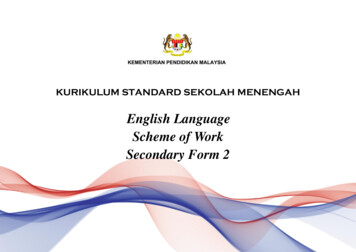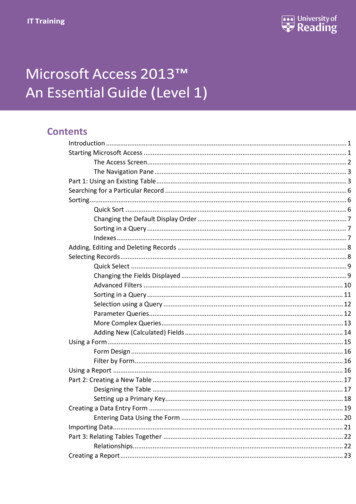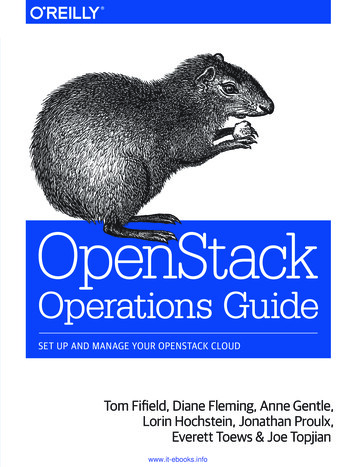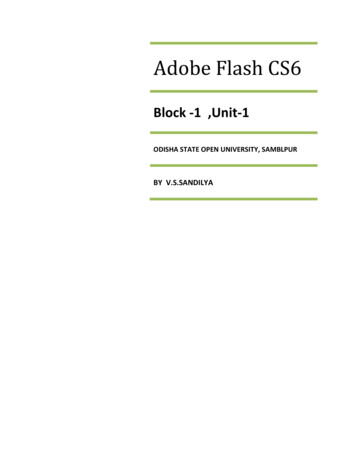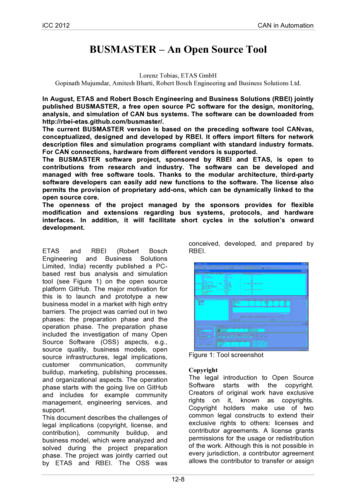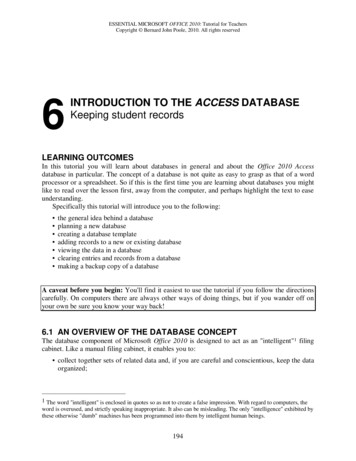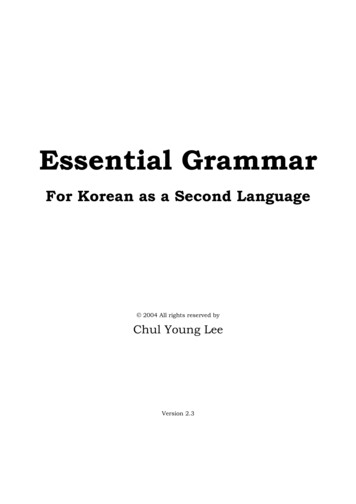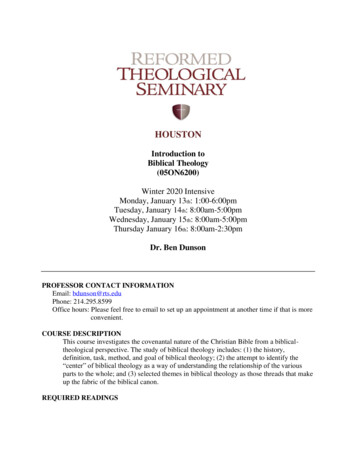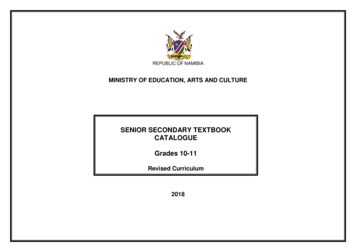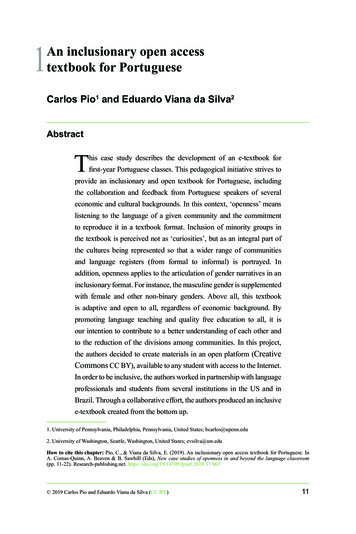
Transcription
1An inclusionary open accesstextbook for PortugueseCarlos Pio1 and Eduardo Viana da Silva2AbstractThis case study describes the development of an e-textbook forfirst-year Portuguese classes. This pedagogical initiative strives toprovide an inclusionary and open textbook for Portuguese, includingthe collaboration and feedback from Portuguese speakers of severaleconomic and cultural backgrounds. In this context, ‘openness’ meanslistening to the language of a given community and the commitmentto reproduce it in a textbook format. Inclusion of minority groups inthe textbook is perceived not as ‘curiosities’, but as an integral part ofthe cultures being represented so that a wider range of communitiesand language registers (from formal to informal) is portrayed. Inaddition, openness applies to the articulation of gender narratives in aninclusionary format. For instance, the masculine gender is supplementedwith female and other non-binary genders. Above all, this textbookis adaptive and open to all, regardless of economic background. Bypromoting language teaching and quality free education to all, it isour intention to contribute to a better understanding of each other andto the reduction of the divisions among communities. In this project,the authors decided to create materials in an open platform (CreativeCommons CC BY), available to any student with access to the Internet.In order to be inclusive, the authors worked in partnership with languageprofessionals and students from several institutions in the US and inBrazil. Through a collaborative effort, the authors produced an inclusivee-textbook created from the bottom up.1. University of Pennsylvania, Philadelphia, Pennsylvania, United States; bcarlos@upenn.edu2. University of Washington, Seattle, Washington, United States; evsilva@uw.eduHow to cite this chapter: Pio, C., & Viana da Silva, E. (2019). An inclusionary open access textbook for Portuguese. InA. Comas-Quinn, A. Beaven & B. Sawhill (Eds), New case studies of openness in and beyond the language classroom(pp. 11-22). Research-publishing.net. https://doi.org/10.14705/rpnet.2019.37.963 2019 Carlos Pio and Eduardo Viana da Silva (CC BY)11
Chapter 1Keywords: Portuguese, e-textbook, textbook, open educational resource, diversity,inclusion, LGBTQI.1.Context of the projectThe curriculum of Portuguese as an additional language has been dominated by afew textbooks, most of them published in Brazil, Portugal, and the US. In general,the textbooks are expensive and in the case of the US, the market is controlledmainly by one publishing house which charges a fee for temporary access to theonline workbook, substantially raising the costs to students. Given the limiteddemand for Portuguese – it corresponds to less than 1% of the foreign languagestaught in the US (Looney & Lusin, 20183) – publishing houses tend to limit thepublication of new textbook editions, which is visible in the outdated material.According to our experience, introductory language books for Portuguese aremostly written by language specialists who do not teach introductory levelclasses. In the end, most of the activities in the textbooks have not been testedwith students before, and sometimes do not work in a class setting. Finally,language textbooks printed outside Portuguese-speaking countries are writtenby language professionals who generally have not been in contact with everydayand current Portuguese for many years, which is noticeable in the wordchoices and the outdated usage of language expressions. The writing processof printed textbooks for Portuguese follows a top-down approach, which limitsthe representation of cultural aspects to those experienced by the authors.It is not uncommon to sense a unifying cultural voice throughout a languagetextbook, instead of multiple voices. The representation of minority groups isoften left to readings and blurbs instead of being an integral part of the material(for a discussion on the underrepresentation of minorities in English textbooks,including women, people of colour, low-income people, and the disabled, seeHilliard, 2014; Kubota, Austin, & Saito-Abbott, 2003).3. In the 2016 Modern Language Association of America report, Portuguese corresponds to 0.69% of the enrollments inforeign languages in institutions of higher education in the US.12
Carlos Pio and Eduardo Viana da SilvaThe idea of developing an open e-textbook for Portuguese grew from theexperience of the authors who have taught entry-language classes at universitylevel for over 15 years each. Having developed several class activities over theyears tailored to their classes and having to adapt most of the textbooks’ contentin order to provide a more natural usage of Portuguese, the authors decided towork with colleagues and students in order to create an open e-textbook. Thegoal of this project is to provide language learners with an e-textbook that iscurrent, free of charge, and available to anyone with access to the Internet. Thismaterial is tailored to university students, however, most of the book couldalso work with high school students and with adults in general. Furthermore,this e-textbook is also a tool for other Portuguese language teachers. Thedevelopment of this material is a collective effort. It involves the participation ofseveral language students and Portuguese instructors in Brazil, the United States,and Portugal (and in the future, Portuguese-speaking countries in Africa). Mostof the writing has been done in Brazil and Portugal, taking into considerationthe result of surveys with students and instructors. Overall, the material reflectsseveral voices and gives prominence to minority groups and gender equalitythroughout the text, including the representation of the Lesbian, Gay, Bisexual,Transgender, Questioning, and Intersex (LGBTQI) community and otherdisenfranchised groups, such as immigrants in Brazil and Portugal, for example.2.Intended outcomesCurrent Portuguese as a foreign language books do not offer a sufficient rangeof real language, despite the fact that they make an effort in taking the languageoutside the classroom and making it more real. There is the need to take astep further by presenting everyday language spoken by Portuguese speakersfrom several backgrounds. This real use of language is a learning outcomethat many instructors struggle to achieve in their classrooms. Realness andopenness occur when listening to the language in use in a given community,taking into consideration all of its sociological variables such as economicstanding, ethnicity, origins and citizenship, and the willingness to reproducesuch language in the textbook format (Pérez-Leroux & Glass, 2000). To include13
Chapter 1these variables entails a shift in paradigm from teaching and learning languagesbelieving that only a speaker who speaks really ‘well’ a language can producemeaningful input versus believing that any speaker can produce meaningfulinput acknowledging the effectiveness of their message according to a specificsocial situation (Mendonça, 2012). In other words, the input in Portugueseproduced by a speaker in a musseque (slum) in Luanda is as valid as the inputin Portuguese produced by a speaker brought up in the middle class, holding auniversity degree in Lisbon, or by a speaker who speaks Uruguayan Portugueseon the border between Brazil and Uruguay. All of them should be included inthe classroom so that students understand why and how they can use the targetlanguage and what to do with it.The inclusion of minority groups in the textbook is then to be perceived not as‘curiosities’ but as an integral part of the country being represented so that awider range of communities and language registers (from formal to informal)is exemplified. Also, openness applies to the articulation of gender narratives inan inclusionary format. In Portuguese, gender is expressed through two classicforms, -a for feminine and -o for masculine. So both should be alternated withnon-binary grammatical uses (namely tod@s, todxs, tod s, todos, todas).In regards to technological tools, discussion boards, such as the ones onBlackboard, Canvas, and Moodle, are a great tool for addressing complexconcepts in a language class, like the definition of ethnicity, colour, citizenship,gender, and sexuality. A Romani student may encounter difficulties in aclassroom whose majority is non-Romani, so a blog functions as a safe stress-freeenvironment for that student or any other to choose or express her/his origins.Also, the definition – and even the explanation – in the classroom of a groupother than the majority may cause confrontation and anxiety, so an educationalblog is a less heated environment for a larger discussion, rather than utilisingstandard definitions given by a ‘normal’ or ‘classic’ discourse of a language anda culture which leaves out everyday important and real expressions of the self.Another outcome in this project is the application of inclusive language. Whendealing with race, the classic explanation of Black culture in Portuguese14
Carlos Pio and Eduardo Viana da Silvaspeaking countries is given by saying that preto and negro refer to the samecolour, but negro should be used for Afro-Brazilians or Afro-Portuguese andpreto for objects. Nonetheless, what do instructors say to students when theirBrazilian and Portuguese friends do not call themselves negro but preto andwhen the characters of the videos, movies, and documentaries they watchaddress their African origins using words such as caboclx, negrx, pretx,morenx, morenx clarx, or cafusx to express their different shades of blackness?An inclusive material should provide other words besides negro and preto sothat an African descendant student can express her/his identity in the targetlanguage more properly (and, more importantly, as one chooses to). Thisconcept applies as well for a lesbian student, for example, who chooses toreveal her sexual preferences or identity not in a classroom but rather in ablog.Finally, language textbooks frequently create a deceiving narrative of inclusionand equality. The perpetuation of a single voice throughout language textbooks,the voice of privileged writers, is many times confused with false ideas ofequality. The authors of the Portuguese textbook – Bate Papo – strongly believethat in order to include authentic perspectives of minorities in textbooks, themembers of the minority groups should participate as collaborators in thecreation of the teaching material. There is an eminent risk of creating clichés andreinforcing stereotypes when a textbook author creates the ‘voices’ of minoritieswithout being a part of the given minority group.3.Nuts and boltsThis Portuguese textbook Bate Papo was created as an electronic text with aCreative Commons license (CC BY), which allows anyone to share and adaptthe material as long as the appropriate credit is given. The textbook is availableonline, on Word, and on PDF as well, so students can print it at home. Sinceit is an electronic textbook, the authors are able to make changes and reviewthe material on a regular basis, keeping it up-to-date, reflecting the changes inthe language, and including current cultural manifestations as well. The text is15
Chapter 1available through the PressBooks platform from the University of Washington:https://uw.pressbooks.pub/batepapo/ – which is currently under construction, asthe authors are releasing the chapters once they are piloted with their languageclasses. The selection of images represents the book’s intention of beingtruly inclusive. The sample below from Unit 2, which focusses on physicaldescriptions, has the image of Marielle Franco (Figure 1), an Afro-Brazilianpolitician and activist, who was assassinated in 2017.Figure 1. Introduction to Unit 2In the same unit about physical descriptions, other images include iconicfigures in the Portuguese-speaking world who are not generally portrayed intraditional language textbooks, such as the Afro-Brazilian reporter Glória Maria,the Brazilian iconic transexual, Gilberta Salci Júnior, and the Guiné Bissaupolitician, Amílcar Cabral (Figure 4). One other activity is the celebration ofAfro Lusophone History Month (Figure 2), in which students are asked to searchinformation about individuals who have been important for Black history in theLusophone world and how they might relate these people’s accomplishmentsto their own cultures (Figure 3). For example, Paulina Chiziane, one of the firstwomen writers from Mozambique; Mamadou Ba, head of the SOS Racism16
Carlos Pio and Eduardo Viana da SilvaAssociation in Portugal; and Brazilian Geanine Escobar, activist for the BlackLesbian Women rights in Portugal.Figure 2. Cultural activityFigure 3. Activity prompts17
Chapter 1Figure 4. Vocabulary for physical descriptionsIn addition to the iconography, a series of short videos were producedportraying everyday life from different ethnicities people in Brazil in severalsituations, such as greeting each other and purchasing an item in a store, forexample. Besides the diversity shown in the videos, the material presents aseries of Portuguese dialects from several regions of Brazil and from differentsocioeconomic backgrounds. Since the content of the book is built from theconversation in the dialogues, the language being studied is the language used ineveryday Portuguese. The authors worked carefully with the contributors for thevideos by giving them the freedom of choosing the words that they would usenormally, without a rehearsed transcript. The result is a more natural language.The expressions and language structures introduced in the dialogues are thenexplained through a Portuguese/English glossary and by focussing on the task athand, allowing students to complete simple tasks despite the complexity of thelanguage. It was clear to the authors that the conversations recorded on videobrought a range of expressions, accents, intonations, language structures, andvocabulary that would not be represented otherwise.As for the online workbook that accompanies the e-textbook, the exercises arecurrently available as Creative Commons on the Canvas platform. In the future,18
Carlos Pio and Eduardo Viana da Silvathe online workbook will also be available on the Moodle and Blackboardplatforms. Although this Portuguese e-textbook is innovative and inclusive, theauthors recognise the importance of also offering the traditional automated onlineexercises as language practice, especially at the lower levels of proficiency. Theonline exercises range from controlled exercises to open ones.One challenging aspect of the online workbook is the series of exercises that arecorrected by the online platforms (Moodle, Canvas, and Blackboard). There arelimitations in the correction system due to the capabilities of the technologicaltools. For instance, when a student misses an accent, the whole answer isconsidered wrong, despite it being a single accent missing. It will probably bethe case that in the future, these online platforms will be more refined and ableto detect different kinds of answers and scale the grade according to the numberof inaccuracies.Another aspect that contributed to the development of this e-textbook inPortuguese is the use of other open educational resources, especially the podcastsLíngua da Gente, produced by Orlando Kelm and available at the Centre forOpen Educational Resources and Language Learning at the University of Texasat Austin (https://linguadagente.coerll.utexas.edu/). The podcasts focus on ashort dialogue between two Brazilians and are listed according to the level ofproficiency being targeted: beginner, elementary, and intermediate. Anotherimportant open source is the grammar book Português para Principiantes (https://wisc.pb.unizin.org/portuguese/), available through the University of WisconsinMadison, on their PressBooks platform. Their grammar explanations wereincorporated in Bate Papo. At the end, thanks to the open educational resources,Língua da Gente and Português para Principiantes, the e-textbook Bate Papois richer and more complete. The authors can then focus on interactive classactivities and aspects not yet covered or not dealt with well by previous textbooksin Portuguese, such as the inclusion of LGBTQI voices and the representationof indigenous and Afro populations from the Portuguese-speaking world, forexample. The reusing and remixing of digital open educational resources worksas an advantage to educators who are constantly looking for ways to improvetheir teaching materials.19
Chapter 1The book Bate Papo is designed into two versions. In the first stage, the languagefocus is on Brazilian Portuguese. All the videos and most of the collaborators inthis first version of the book come from Brazil, including professors and studentsin applied linguistics. In a second and future stage, the book will focus also onEuropean Portuguese. The plan is to reproduce the majority of the content fromthe Brazilian Portuguese textbook contextualised in an European Portugueseversion. The e-textbook will then be offered in two versions: BrazilianPortuguese and European Portuguese. The fact is that Brazilian Portuguese andEuropean Portuguese are linguistically and culturally very different. A thirdproposal is an African Portuguese version of the textbook, which should comefrom collaborators in Mozambique and Angola.Finally, the authors will provide a print-on-demand version of the material ona low-cost option (around USD20) for those who prefer to have the printedmaterial on hand during class time, even though there is the possibility ofprinting a PDF or Word Copy available online. The collaborators in languageschools and higher education institutions in Brazil have already signaled theirintentions of adopting this e-textbook. It comes as no surprise that schools withimmigrant populations in Brazil find this material very helpful with its grammarexplanations and glossaries in English, according to Nildicéia Aparecida Rocha,from the Universidade Estadual Paulista (personal communication, June 21,2018). Programmes for immigrant students in Brazil have struggled withteaching material that lacks a common language for their target audiences.In practical terms, to make the e-textbook Bate Papo available to a largeraudience and to make it truly open will involve massive promotion withPortuguese language instructors, students, universities, colleges, public andprivate language schools, non-profit organisations, and the social media. Theintention of having this e-textbook as an open educational resource is also togive an opportunity to underprivileged students to study Portuguese with aquality material that represents the diversity of the Portuguese-speaking worldand which is also free. Since platforms such as Canvas and Blackboard4 are4. Canvas is a free and open platform, whereas Blackboard charges a fee.20
Carlos Pio and Eduardo Viana da Silvanormally used at universities and colleges in the United States, the possibility ofhaving a Portuguese Massive Open Online Course (MOOC) using the resourcesin Bate Papo will also be considered as the project takes its form. The advantageof using a MOOC is that they provide access to students from all over the worldfor free.4.ConclusionWhen creating new foreign language materials, one should have in mind theever more diverse audience they are addressing so that a more fruitful, effective,engaging, and real environment is achieved5. In addition to the paucity of studiesand approaches devoted to the inclusion of marginalised groups in Portugueselanguage activities, the inclusion of sociological categories such as dialect,sociolect, ethnicity, sexual orientation, and religion, among others, in currenttextbooks is sometimes not acknowledged or, if so, accounted for in a side note(for a more in-depth discussion on queer pedagogy in Portuguese languagematerials, see Neto, 2016). This case study is meant to open the dialogue interms of the representation in the classroom of sociological groups other thanthe majority and far from the idea of a unified non-real language. Being moreaccessible, open, real, and free, the new e-textbook is not so much concernedwith how to speak proper Portuguese in one way, but how to use Portuguese indifferent settings and allowing one’s individuality.AcknowledgementsThank you Ana Cristina B. Salomão and Nildicéia Rocha from the UniversidadeEstadual Paulista and Leandro Rodrigues Alves Diniz from the UniversidadeFederal de Minas Gerais. We are also grateful to the Centre for Latin American5. Otlowski (2003) stresses this same need in the case of English as a Foreign Language (EFL): “the teacher and thetextbook are the two most important and immediate cultural links between the student’s native culture and the target foreignculture. If the influential roles of the teacher and the textbook are accepted, then the way the textbook portrays the variouspeople in the target society and the way those people are shown to communicate will directly affect EFL students’ choices oflanguage when communicating with native speakers. This has important implications for the EFL teacher and for textbookselection” (p. 2).21
Chapter 1Studies at the University of Florida and to our institutions, the University ofWashington and the University of Pennsylvania. This e-textbook has also beensupported through the UW Libraries Open Textbook Award. Last but not least,a massive thank you to Sarah Sweeney, the project coordinator at the Centrefor Open Educational Resources and Language Learning (COERLL) at theUniversity of Texas, Austin. Sarah has been a long-term supporter of this project.We cannot forget all the students, language instructors, and volunteers involvedin this project as well. Thank you very much! Obrigado!ReferencesHilliard, A. D. (2014). A critical examination of representation and culture in four Englishlanguage textbooks. Language Education in Asia, 5(2), 238-252. Kubota, R., Austin, T., & Saito-Abbott, Y. (2003). Diversity and inclusion of sociopoliticalissues in foreign language classrooms: an exploratory survey. Foreign Language Annals,36(1), 12-24. Looney D., & Lusin, N. (2018). Enrollments in languages other than english in UnitedStates institutions of higher education, Summer 2016 and Fall 2016: preliminaryreport. Modern Language Association of America. /2016-Enrollments-Short-Report.pdfMendonça, J. T. de (2012). O ensino de língua portuguesa e a sua relação com a inclusão/exclusão social. Anais do SIELP, 2(1), 1-13. oads/2014/07/volume 2 artigo 151.pdfNeto, J. N. (2016). Pedagogia Queer e Ensino: a representação LGBT nos livros de portuguêscomo língua estrangeira. In I. Fortunato, R. S. Guimarães & V. Vergueiro (Eds), Gênero eCultura: Perspectivas Formativas (pp. 23-35). Edições Hipóteses.Otlowski, M. (2003). Ethnic diversity and gender bias in EFL textbooks. Asian EFL Journal,5, 1-15. http://www.asian-efl-journal.com/june 03 mo.pdfPérez-Leroux, A., & Glass, W. R. (2000). Linguistic diversity and inclusion in theforeign language classroom. Foreign Language Annals, 33(1), 58-62. 22
Published by Research-publishing.net, a not-for-profit associationVoillans, France, info@research-publishing.net 2019 by Editors (collective work) 2019 by Authors (individual work)New case studies of openness in and beyond the language classroomEdited by Anna Comas-Quinn, Ana Beaven, and Barbara SawhillPublication date: 2019/07/26Rights: the whole volume is published under the Attribution-NonCommercial-NoDerivatives International(CC BY-NC-ND) licence; individual articles may have a different licence. Under the CC BY-NC-ND licence,the volume is freely available online 511) for anybody toread, download, copy, and redistribute provided that the author(s), editorial team, and publisher are properly cited.Commercial use and derivative works are, however, not permitted.Disclaimer: Research-publishing.net does not take any responsibility for the content of the pages written by theauthors of this book. The authors have recognised that the work described was not published before, or that itwas not under consideration for publication elsewhere. While the information in this book is believed to be trueand accurate on the date of its going to press, neither the editorial team nor the publisher can accept any legalresponsibility for any errors or omissions. The publisher makes no warranty, expressed or implied, with respect tothe material contained herein. While Research-publishing.net is committed to publishing works of integrity, thewords are the authors’ alone.Trademark notice: product or corporate names may be trademarks or registered trademarks, and are used only foridentification and explanation without intent to infringe.Copyrighted material: every effort has been made by the editorial team to trace copyright holders and to obtaintheir permission for the use of copyrighted material in this book. In the event of errors or omissions, please notifythe publisher of any corrections that will need to be incorporated in future editions of this book.Typeset by Research-publishing.netCover design by Raphaël Savina (raphael@savina.net)ISBN13: 978-2-490057-51-1 (Ebook, PDF, colour)ISBN13: 978-2-490057-52-8 (Ebook, EPUB, colour)ISBN13: 978-2-490057-50-4 (Paperback - Print on demand, black and white)Print on demand technology is a high-quality, innovative and ecological printing method; with which the book isnever ‘out of stock’ or ‘out of print’.British Library Cataloguing-in-Publication Data.A cataloguing record for this book is available from the British Library.Legal deposit, UK: British Library.Legal deposit, France: Bibliothèque Nationale de France - Dépôt légal: juillet 2019.
Keywords: Portuguese, e-textbook, textbook, open educational resource, diversity, inclusion, LGBTQI. 1. Context of the project The curriculum of Portuguese as an additional language has been

